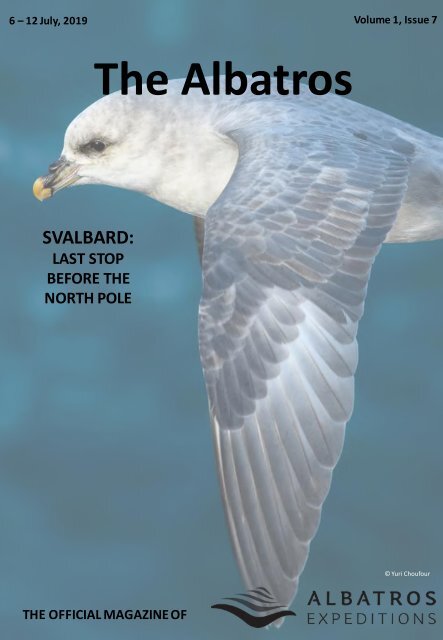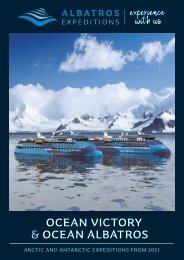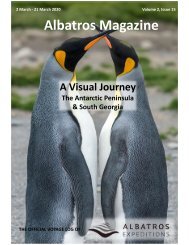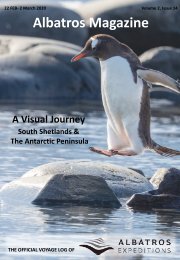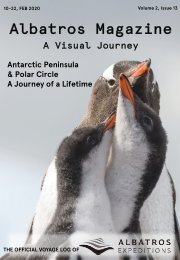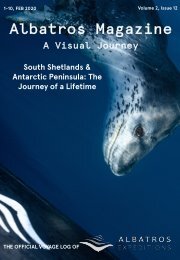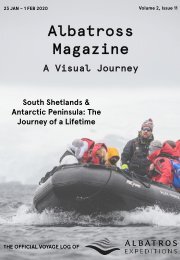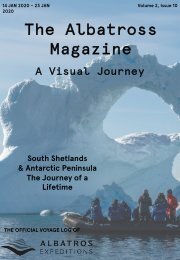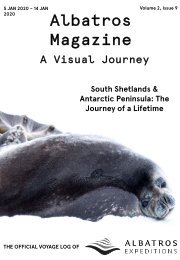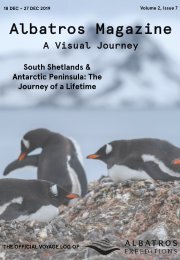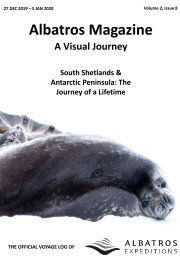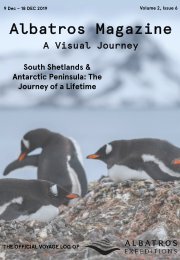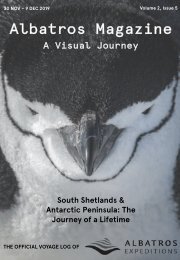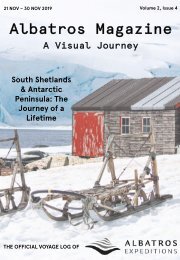Voyage Log July 06 SVALBARD
- No tags were found...
Create successful ePaper yourself
Turn your PDF publications into a flip-book with our unique Google optimized e-Paper software.
6 – 12 <strong>July</strong>, 2019 Volume 1, Issue 7<br />
The Albatros<br />
<strong>SVALBARD</strong>:<br />
LAST STOP<br />
BEFORE THE<br />
NORTH POLE<br />
© Yuri Choufour<br />
THE OFFICIAL MAGAZINE OF
The Albatros<br />
Editor-in-Chief:<br />
Staff Writers:<br />
Layout & Design:<br />
Expedition Leader:<br />
Assistant Expedition Leader:<br />
Shop Manager:<br />
Expedition Photographer:<br />
Zodiac Master:<br />
Kayak Master:<br />
Rifle Master:<br />
Expedition Guide/Lecturer:<br />
Front Cover Image:<br />
Back Cover Image:<br />
Photography Contributors:<br />
Yeti (Jes Gravgaard)<br />
Amanda Dalsgaard<br />
Yeti and Gaby Pilson<br />
Bernabe Urtubey<br />
Steve Egan & Lars Maltha Rasmussenen<br />
Nadine Smith<br />
Yuri Choufour<br />
Steve Traynor<br />
Slava Nikitin<br />
Stefano Tricanico<br />
Amanda Dalsgaard<br />
Rashidah Lim<br />
Wan Meng Chieh<br />
Wilson Cheung<br />
Aviajaja Schlüter<br />
Yeti Gravgaard<br />
Jim Cao<br />
James Floyd<br />
Emil Maltha Rasmussen<br />
Kittiwake © Yuri Choufour<br />
Ny-Ålesund © Gaby Pilson<br />
Renato Granieri Photography<br />
Gaby Pilson<br />
Yuri Choufour<br />
© Gaby Pilson<br />
6-12 <strong>July</strong>, 2019 Volume 1, Issue 7
TABLE OF CONTENTS<br />
The <strong>Voyage</strong><br />
By the Numbers<br />
Day 1: Into the wild<br />
The Seven Sisters of Szczecin<br />
The King of the Arctic<br />
Day 2: Hottest Day in the Arctic<br />
Day 3: North to 80 o 21.541’N<br />
Ice is Nice – Glacier Fun Facts<br />
Day 4: Ny Ålesund and Ny London<br />
Day 5: Icy Waters<br />
Svalbard: A Breeding Ground for<br />
Migrant Birds<br />
Day 6: The final day<br />
Polar Diplomacy<br />
A Brief History of the Zodiac<br />
Day 7: Home Again<br />
A Final Note<br />
4<br />
5<br />
6<br />
7<br />
8<br />
9<br />
10<br />
11<br />
12<br />
13<br />
14<br />
15<br />
16<br />
17<br />
18<br />
19
By the Numbers…<br />
Page 5<br />
<strong>Voyage</strong> Statistics:<br />
Northernmost Point:<br />
Total Distance Travelled:<br />
80 o 21.541’N, 10 o 08.286’E<br />
554 nautical miles<br />
Excursion Locations:<br />
Longyearbyen: 78 o 12.651’N, 15 o 32.408’E<br />
Billefjord: 78 º 28.702’N, 14 º 15.457’E<br />
Signahamna: 79 o 16.362’N, 11 o 34.<strong>06</strong>1’E<br />
Møllerfjorden: 79 º 16.502’N, 11 º 51.052’E<br />
Pack Ice Cruise: 80 o 21.541’N, 10 o 08.286’E<br />
Ny-Ålesund: 78 o 54.871’N, 11 o 59.759’E<br />
Ny-London: 78 o 56.237’N, 12 o 01.548’E<br />
14 Julibukta: 79 o 07.554’N, 11 o 48.352’E<br />
Alkhornet: 79 o 13.110’N, 13 o 52.685’E<br />
Poolepynten: 78 o 27.201’N, 11 o 51.156’E<br />
Longyearbyen: 78 o 12.651’N, 15 o 32.408’E<br />
6-12 <strong>July</strong>, 2019<br />
Volume 1, Issue 7
The <strong>Voyage</strong><br />
Page 4<br />
The following map traces the approximate route that the M/V Ocean Atlantic took during our<br />
voyage around Svalbard. You can find more information about our day to day activities, landings,<br />
and excursions on the following pages. We hope that this magazine serves as a reminder of all of<br />
the wonderful memories you made while experiencing the Arctic with us at Albatros Expeditions.<br />
© Renato Granieri Photography © Yuri Choufour<br />
6-12 <strong>July</strong>, 2019<br />
Volume 1, Issue 7
DAY 1: Into the wild<br />
6 <strong>July</strong> 2019 - Embarkation Day<br />
As our flights touched down on the runway in<br />
Longyearbyen, we were treated to delightful views of<br />
the Arctic landscape that will become our playground<br />
for the next week. Weary from our early morning<br />
flights, yet excited for the adventure to come, we<br />
immediately journeyed into town for some quick city<br />
exploration inLongyearbyen.<br />
The story of Longyearbyen is short, but industrial,<br />
although it didn’t start out that way. As the history<br />
books tell us, the notion of Longyearbyen as a<br />
potential settlement first came about when John<br />
Munro Longyear was on an Arctic cruise with his<br />
family in 1903. While sailing around the many fjords<br />
that make Svalbard the picturesque landscape we<br />
know and love, Longyear spotted some potential coal<br />
mining opportunities in Isfjord. By 19<strong>06</strong>, he began his<br />
mining operations in what was then known as<br />
Longyear City.<br />
Page 6<br />
From the <strong>Voyage</strong> <strong>Log</strong><br />
© Yuri Choufour<br />
Once we got our fill of the shopping and walking<br />
opportunities in Longyearbyen, we headed off to<br />
the pier to finally embark on our new home, the<br />
M/V Ocean Atlantic, via a short, but exciting Zodiac<br />
ride - our first of many on this expedition. After the<br />
hotel check-in process was complete, we were<br />
treated to a scrumptious afternoon tea, before our<br />
mandatory safety drill in the late afternoon. Soon<br />
enough, we were casting away the bowlines,<br />
heading away from our safe harbour, and<br />
journeying out to sea, intrue expedition style.<br />
After our safety drill, we had an opportunity to<br />
wander around the ship and acquaint ourselves<br />
with our new home. Before long, however, we<br />
gathered up in the Viking Lounge yet again for an<br />
introductory briefing with Expedition Leader Berna<br />
Urtubey and his 16 expedition staff members.<br />
© Yuri Choufour<br />
Although coal mining is no longer as abundant as it<br />
once was in Svalbard, it has forever left its mark on<br />
the region, least of all by creating the small, but<br />
bustling settlement of Longyearbyen. These days,<br />
however, Longyearbyen is a centre for international<br />
science efforts, tourism, and conservation, and, most<br />
importantly for us: the starting point on our journey.<br />
As we’re on an expedition, we know full well that<br />
there are no guarantees. We are at the mercy of the<br />
weather, the wildlife, and the landscape of this cold<br />
and often inhospitable place. But, as explorers know<br />
all too well, we can only ever experience true<br />
beauty in nature when we are brave enough to seek<br />
it out amongst the mountains and the seas in the<br />
world’s most remote places. It is with that<br />
sentiment in mind that we venture away from<br />
Longyearbyen and north, to the future and all the<br />
wonders itholds.<br />
“<br />
We can only ever experience true<br />
beauty in nature when we are<br />
brave enough to seek it out…<br />
”<br />
© Yuri Choufour<br />
6-12 <strong>July</strong>, 2019 Volume 1, Issue 7
The Seven Sisters of Szczecin<br />
David MacDonald, Lecturer (Geology) & Expedition Guide<br />
M/V Ocean Atlantic was launched in 1986 as the<br />
last-built of the ‘Shoshtakovich’ class of icestrengthened<br />
passenger vessels, alongside six sister<br />
ships, together known as the “Seven Sisters of<br />
Szczecin.<br />
Her original name was Konstantin Chernenko<br />
(Константин Черненко), after the President of the<br />
USSR (1984-1985). She was renamed Russ (Русс) in<br />
1989, and spent much of her life working in the<br />
Russian Far East.<br />
She was purchased by Albatros Expeditions and<br />
completely refitted in 2017. She is now a 200-<br />
passenger expedition vessel and is one of the<br />
strongest polar cruise ships afloat. Here are some<br />
fun facts about the “Seven Sisters”:<br />
• All seven ships were built by Stocnia Szczecinska<br />
shipyard inSzczecin, Poland between 1979-1986<br />
• Main engines: 4 x Skoda Sulzer 6LZ40 total power<br />
12800 kW, giving a maximum speed of 18 knots<br />
• Most of the class have one bow thruster (736 kW)<br />
and one stern thruster (426 kW); however, two<br />
ships, including ours, built in 1986, have two stern<br />
thrusters, each of 426 kW<br />
• Feature Siemens stabilisers for seaworthiness<br />
• Although built as ferries, they have a<br />
strengthened car deck for transport of tanks<br />
• Two of them had diving chambers<br />
• MV Mikhail Sholokov had hull demagnetising<br />
Page 7<br />
equipment so itcould operate inminefields<br />
• All of these ships have been scrapped except ours<br />
and Konstantin Simonov –now Ocean Endeavour<br />
Our ship has had a complex history:<br />
1986-1987 In Baltictraffic, then Vladivostok to<br />
Japan & S Korea<br />
1989 renamed to Russ<br />
1997-1999 In traffic Stockholm-Riga; 2000<br />
Odessa-Haifa; 2002 back to<br />
Vladivostok transporting cars from<br />
Japan<br />
2007 Sold to Sea Ferry Shipping inMajuro<br />
and renamed 2010 to Atlantic;<br />
renovations inItaly and intraffic<br />
Stockholm-Helsinki-St.Petersburg<br />
during summer and laid up (October<br />
2010) inSt Petersburg<br />
2012 Sold to ISP inMiami and renamed to<br />
Ocean Atlantic under Marshall<br />
Islands flag<br />
2013 Used as a hotel ship inthe German<br />
bight wind farm project<br />
2015-2017 Laid up inHelsingborg and taken to<br />
Gdansk in Poland, where totally<br />
refitted<br />
2017 Chartered to Quark Expeditions<br />
2017-present Chartered to Albatros Expeditions.<br />
© Renato Granieri Photography<br />
6-12 <strong>July</strong>, 2019<br />
Volume 1, Issue 7
The King of the Arctic<br />
Gaby Pilson, Hiking Master & Expedition Guide<br />
Polar bears are the veritable king of the Arctic, despite their often elusive nature in front of human visitors.<br />
But, despite their cute, cuddly, and charismatic appearance, polar bears are fantastically well-adapted to live<br />
in their harsh Arctic landscape. Here are some great fun facts about polar bears:<br />
1<br />
Although those cute and cuddly little polar<br />
bear cubs look shiny and white in photos, polar<br />
bears are actually black! Polar bears have black<br />
skin with a thick coat of transparent fur rather<br />
than the white fur and skin we’ve always<br />
imagined. The black skin helps the bear absorb<br />
sunlight and retain heat in cold arctic<br />
conditions. Polar bear fur contains no white<br />
pigment and simply appears white because of<br />
how sunlight is reflected off of the bear. This<br />
fur is critical for a polar bear, as it allows them<br />
to hunt while staying well-camouflaged among<br />
snowdrifts.<br />
3<br />
Polar bears are patient hunters. Instead of<br />
chasing prey, they sit and wait for hours or<br />
days at seal breathing holes in the ice until the<br />
opportune moment arises. Seals surface every<br />
five to fifteen minutes at these breathing<br />
holes, so polar bears need to be ready at a<br />
moment’s notice. Luckily, polar bears can use<br />
their acute sense of smell to stalk prey without<br />
expending too much energy. Polar bears will<br />
sniff out a seal from up to a mile away and<br />
through the sea ice, so they can sit and wait by<br />
the right breathing hole. These bears show us<br />
that laziness can, indeed, be a virtue.<br />
Page 8<br />
2<br />
These<br />
graceful bears can be difficult to study in<br />
the wild, as harsh conditions and remote<br />
locales conspire against scientists. Fortunately,<br />
scientists have developed a new technique<br />
that allows them to extract DNA from polar<br />
bear footprints. Using just two tiny samples of<br />
snow from a polar bear footprint, scientists in<br />
Svalbard were able to extract DNA from the<br />
bear and its most recent seal-based meal. The<br />
scientific community hopes that this new<br />
technique can help contribute to research on<br />
polar bears and help make tracking and<br />
monitoring the animals more accurate and<br />
efficient.<br />
© Renato Granieri Photography<br />
6-12 <strong>July</strong>, 2019<br />
© Renato Granieri Photography<br />
4<br />
After<br />
a long winter in a snow den, polar bear<br />
mothers emerge from their winter homes into<br />
the spring sunshine with up to three cubs.<br />
Although cubs emerge from the den about the<br />
size of a small dog, when they are born, they’re<br />
just 30cm (1ft) long and weigh only 450g (1lb).<br />
Newborn polar bear cubs are blind, toothless<br />
and completely dependent on mum for food<br />
and warmth. They nurse on their mother’s milk<br />
(which is nearly 30% fat!) to help them grow<br />
quickly. Polar bear cubs will continue nursing<br />
for nearly two years until they’re ready to start<br />
hunting and eating seals alongside their<br />
mothers.<br />
Volume 1, Issue 7
DAY 2: Hottest Day in the Arctic<br />
7 <strong>July</strong> 2019 – Lilliehookbreen & Regnardnest<br />
Page 9<br />
From the <strong>Voyage</strong> <strong>Log</strong><br />
The M/V Ocean Atlantic sailed through Cross Bay<br />
and into Krossfjorden around the time the sun would<br />
normally be rising in our homelands. However, as we<br />
arrived to our afternoon destination, it was shining<br />
brightly and had been all night long, here in the land<br />
of the midnight sun.<br />
The journey down the dramatic Lilliehookfjorden<br />
ends in the spectacular 11 km wide glacier named<br />
Lilliehookbreen, our destination for this morning’s<br />
Zodiac cruise. Lilliehookbreen is fed by ten large<br />
tributary glaciers and an even greater number of<br />
smaller ones making it one of the largest glacier on<br />
the west coast of Spitsbergen.<br />
The weather was stunning with blue skies and no<br />
wind, making for excellent photography conditions<br />
to capture the mirror effect of the glacier on the icy<br />
cold waters below. An abundance of Arctic terns,<br />
kittiwakes, guillemots, northern fulmars and<br />
common eider ducks perched on the floating glacier<br />
ice or swam about near the Zodiacs.<br />
© Yuri Choufour<br />
© Yuri Choufour<br />
Regnardpynten has historical significance due to the<br />
1910 and 1912 German Zeppelin expeditions. These<br />
early explorers first came here because they initially<br />
believed the area was suitable for an airship base.<br />
Regnardpynten is also home to the historic Lloyds<br />
Hotel. Despite the 5 stars on the door, do not expect<br />
to find establishment offerings of any kind of service<br />
or hospitality. It is simply this is just an unusual small<br />
hut painted bright orange.<br />
Following the tundra walk, the guests were given yet<br />
another chance to Zodiac cruise! This time, it was an<br />
after-dinner activity where guests and guides alike<br />
were greeted by hundreds of sea birds, as well as<br />
many charismatic megafauna hauled up on the ice<br />
floes (harbour seals). All in all, it was a fabulous way<br />
to wrap up our first official day of our Arctic<br />
expedition.<br />
© Yuri Choufour<br />
During lunch, the ship repositioned to a nearby site<br />
called Regnardneset, a historical landing with<br />
wonderful views and another glacier called<br />
Kollerbreen. Guests were soon again embarking onto<br />
the Zodiacs for the short trip ashore to walk amongst<br />
the Arctic tundra and appreciate the newly<br />
blossomed wildflowers at Regnardpynten.<br />
© Steve Traynor<br />
6-12 <strong>July</strong>, 2019<br />
Volume 1, Issue 6
DAY 3: North to 80 o 21.541’N<br />
8 <strong>July</strong> 2019 – Into the endless ice<br />
From the <strong>Voyage</strong> <strong>Log</strong><br />
Page 10<br />
The sea ice in Svalbard is a magical place. In the north<br />
of Svalbard, only the bravest and hardiest of ships<br />
journey to the edge of the ice, while even fewer<br />
actually manage to venture into the pack ice itself.<br />
For those who do, however, the experience is surreal<br />
– densely packed ice as far as the eye can see create<br />
the perfect environment for a number of marine<br />
mammals that rely on the ice for a place to rest, a<br />
place to hunt, or both.<br />
While the sheer experience of sailing into the ice is a<br />
worthy enough reason to head north, like any true<br />
expedition, we travelled into the world of ice and<br />
snow for another chance to see the ever-elusive king<br />
of the Arctic: the polar bear. Although we didn’t<br />
manage to spot any polar bears, we learned much<br />
about these elusive creatures through a couple of<br />
lectures given by Amanda and Wilson during our<br />
voyage to 80 degrees north.<br />
© Yuri Choufour<br />
© Yuri Choufour<br />
© Yuri Choufourc<br />
Soon enough, however, it was time to enjoy the<br />
scrumptious Arctic barbecue, compliments of Chef<br />
Indra and his talented team. Once lunchtime was all<br />
but a distant memory, it was time for our afternoon<br />
activity: a once-in-a-lifetime Zodiac cruise through<br />
Fuglefjord. With our trusty Zodiacs breaking<br />
through small floes of brash ice, we managed to get<br />
up close and personal with dozens of sea birds and<br />
even a minke whale! After a beautiful afternoon<br />
filled with wildlife and remarkable views, he wind<br />
and the cold beckoned us back inside to the<br />
comfort of our ship once more.<br />
If all of that adventure wasn’t sufficient, soon<br />
enough, we gathered back up in the mudroom for<br />
the ultimate Arctic experience: the Polar Plunge.<br />
For the brave few among us, a quick jump into the<br />
icy waters of northern Spitsbergen was a fantastic<br />
way to end a magical day inthe ice.<br />
Thanks to our Captain’s skills and navigation through<br />
the ice-covered sea, we managed to snap some great<br />
photos as well as experience many sea birds on and<br />
above the ice we were cruising through. A great<br />
celebration announcement was set forth as we sailed<br />
passed 80 degrees north. After a while, however,<br />
many of us gave in to the cold, windy conditions,<br />
opting instead to head inside and warm up with a cup<br />
of tea as we enjoyed the icy views from a<br />
cozier location on board.<br />
© Yuri Choufour<br />
© Yuri Choufour<br />
30 June - 6 <strong>July</strong>, 2019<br />
Volume 1, Issue 6
Ice is Nice – Glacier Fun Facts<br />
Gaby Pilson, Hiking Master & Expedition Guide<br />
Glaciers have, quite literally, shaped our world. Without glaciers, the rolling hills and wide valleys we know<br />
today would look very different, but it turns out that these icy giants have a much longer and more storied<br />
history than many of us would initially suspect. Here are some of the best fun facts about glaciers:<br />
2<br />
4<br />
© Renato Granieri Photography<br />
Glaciers are formed by snowflakes. Although it’s<br />
crazy to think that a tiny snowflake can create<br />
something as large as a glacier, without snow,<br />
glaciers would never exist in the first place. To<br />
form a glacier, massive amounts of snow must<br />
accumulate and persist in a single location all<br />
year-long for hundreds, if not thousands of<br />
years. During this time, the individual snowflakes<br />
found in the snowpack change in a process<br />
known as snowflake metamorphosis, where<br />
individual ice grains fuse together and get bigger<br />
and air bubbles get smaller. Once the icepack<br />
builds up enough mass to start flowing downhill,<br />
then voila! We have a glacier.<br />
© Renato Granieri Photography<br />
Page 11<br />
1<br />
Not just anything can be a glacier. In fact, there’s<br />
a size requirement that a piece of ice has to<br />
meet to become a glacier. Anything considered a<br />
glacier must be at least 0.1 km 2 (nearly 25 acres)<br />
in area to be worthy of the name. Although<br />
there’s a minimum size requirement to be<br />
considered a glacier, there’s no upper limit to<br />
glacierhood. The longest glacier on earth is the<br />
Lambert Glacier of Antarctica, which measures<br />
out to some 434 km (270 mi) long. The world’s<br />
largest non-polar glacier is the Fedchenko<br />
Glacier of Tajikistan, which measures a<br />
respectable 77km (48mi) long.<br />
3<br />
© Renato Granieri Photography<br />
Glaciers are found all over the world, not just in<br />
the polar regions. While the majority of glaciers<br />
and glacial ice is concentrated in high northern<br />
and southern latitudes, glaciers are found even<br />
near the equator, such as on Mount Kilimanjaro<br />
in Tanzania and in the mountains of Ecuador.<br />
That being said, about half of the world’s<br />
200,000 glaciers are found in one place: Alaska.<br />
There, glaciers cover a whopping 72,500 km 2<br />
(28,000 mi 2 ) of the US state’s total area. That’s a<br />
lot of ice.<br />
Glaciers are basically really, really, really slow-moving rivers. To be considered a glacier, a large mass of ice<br />
must be physically moving downhill. This movement downhill is driven by gravity and is the main reason<br />
why glaciers also act as major agents of erosion. Since glaciers move downhill, they often remove and<br />
transport large boulders and chunks of rock, depositing them much further downhill then where they<br />
started.<br />
6-12 <strong>July</strong>, 2019<br />
Volume 1, Issue 7
DAY 4:<br />
Ny Ålesund and Ny London<br />
9 <strong>July</strong> 2019<br />
Page 12<br />
From the <strong>Voyage</strong> <strong>Log</strong><br />
In brilliant sunshine and perfectly calm conditions we<br />
landed by zodiac at Ny Alesund and walked up to the<br />
main town. The party split into various groups, one<br />
heading past Roald Amundsen's bust towards the old<br />
mooring mast erected in 1926 for his North Pole<br />
expedition with the airship NORGE.<br />
Another group headed towards the dog compound<br />
looking for wildlife, spotting an ivory gull feeding on<br />
some of the dog rations. Arctic terns nested very close<br />
to (and even on) the road.<br />
Everyone also visited the well-stocked shop where<br />
there was a brisk trade in souvenirs, clothing and soft<br />
toys. Postcards (and stamps) were also popular, with<br />
the added option of posting them from one of the<br />
most northerly post offices in the world. The museum<br />
opposite the shop had excellent displays about the<br />
history of the town. The final stoup around 11am was<br />
at the ‘Yellow River’ Chinese Research Station for a<br />
group photo.<br />
© Gaby Pilson<br />
© James Floyd<br />
Continuing our hike across the barren tundra, we<br />
looked at the wild flowers and colourful lichen. Two<br />
reindeer were spotted, one lying down in the snow<br />
to cool off.<br />
After dinner, we had a Zodiac cruise looking for a<br />
polar bear which has been spotted earlier. It was<br />
located lying down in the grass, though we could not<br />
approach within one mile. After the bear encounter,<br />
we cruised around the bay before returning to the<br />
repositioned ship.<br />
© James Floyd<br />
© Yuri Choufour<br />
In the afternoon we landed on Blomstrand Peninsula<br />
to visit the old quarrying operations at Ny London.<br />
These had been started in 1911 by investors from<br />
London, England, to extract the supposedly excellent<br />
marble. Industrial machinery was installed, including<br />
steam boilers, stone saws and a large crane.<br />
Unfortunately, the marble disintegrated rapidly into<br />
small fragments due to frost action and the operation<br />
was abandoned by 1920.<br />
6-12 <strong>July</strong>, 2019<br />
Volume 1, Issue 7
DAY 5: Icy Waters<br />
10 <strong>July</strong> 2019 – Conway Breen<br />
and 14 th of <strong>July</strong> Breen<br />
Yet again we started the morning with a wakeup<br />
call from our Expedition Leader Berna. After<br />
a quiet night spent at anchor at the Kongsfjord<br />
we were ready to explore more of the<br />
beautiful Svalbard. The Zodiacs were launched,<br />
and the morning was spent cruising around the<br />
Conway Glacier and amongst the icebergs. We<br />
swapped the blue sky of the past days for a<br />
more mystical feeling with slight fog and a<br />
beautiful soft grey light. The chilly breeze gave<br />
us a real Arctic touch and through our camera<br />
lenses we saw the pristine nature glide by.<br />
© Yuri Choufour<br />
On return from our Zodiac exploration most of<br />
us warmed up with a warm cup of tea and<br />
delicious chocolate chip cookies before we<br />
were ready for the amazing Polar Plunge<br />
event. Icy waters, great music, lots of smiles<br />
and a shot of vodka put us all in the right mood<br />
for the big jump. A big congratulations to all<br />
who dared the Arctic waters and plunged into<br />
the big ocean! The cheering from Deck 7 and<br />
the Mudroom made the whole experience<br />
even more special.<br />
Page 13<br />
From the <strong>Voyage</strong> <strong>Log</strong><br />
For all Arctic swimmers and spectators, we<br />
shared a celebratory lunch in high spirit before<br />
we yet again were ready to gear up with warm<br />
clothes and cameras. This time the destination<br />
was the 14th of <strong>July</strong> Glacier with great birdlife<br />
and a bit of a swell. Here we encountered cliffs<br />
with lots of guillemots, colourful puffins,<br />
screeching gulls, and even reindeers. It was<br />
stunning getting close to the bird cliffs and see<br />
the rugged coastline these animals call home.<br />
To top off our Zodiac cruise we went closer to<br />
the glacier and even had a bit of a rumble as<br />
pieces of ice broke off and fell into the water.<br />
Icy blue icebergs covered in kittiwakes was<br />
scattered around the area as we moved through<br />
the waters.<br />
Onboard the ship Wilson animatedly told us<br />
about his Antarctic experiences and his travels<br />
to the South Pole before we dove into the art of<br />
dumpling making. These tasty treats were ready<br />
for us to enjoy at dinner together with a<br />
wonderful buffet dinner.<br />
© Yuri Choufour<br />
© Yuri Choufour<br />
6-12 <strong>July</strong>, 2019<br />
Volume 1, Issue 7
Svalbard: A Breeding Ground for Migrant Birds<br />
Dr. George Swan, Lecturer (Ornithology) & Expedition Guide<br />
Page 14<br />
© Renato Granieri Photography<br />
In 1594, when the Arctic was first being explored,<br />
Gerrit de Veer, an officer on a Dutch ship, noticed<br />
something strange. While the mammals he<br />
encountered were both new and bizarre (think: huge,<br />
tusked seals and massive white bears), some of the<br />
birdlife was very familiar. In fact, several species of<br />
geese seemed exactly the same as those he had seen<br />
grazing in the Netherlands during the winter. He<br />
hypothesised in his journal: could these birds winter in<br />
the Wadden area and summer in the Arctic? De Veer<br />
knew one thing to be certain, however: they certainly<br />
tasted similarly.<br />
We now know that de Veer’s tentative observation<br />
was spot-on and that the birds he encountered were<br />
probably Brent geese (Branta bernicla) who do,<br />
indeed, winter on the eastern coasts of the North Sea<br />
but spend the summer months breeding in the Arctic.<br />
They make their journey down south and up north<br />
every year and, in doing so, join a whole host of other<br />
migratory birds that make use of Svalbard’s short, but<br />
highly productive, breeding season.<br />
Although the geese arrive to forage on the mosses,<br />
saxifrages and other terrestrial plants, it is the<br />
productivity of the inshore waters and surrounding<br />
seas that draws the biggest crowds. Millions of<br />
seabirds arrive from the Barents Sea and the North<br />
Atlantic to breed on Svalbard’s cliffs and feast on the<br />
zooplankton that blooms in the summer’s 24-hour<br />
daylight. Some come from even further afield; Arctic<br />
terns breed on the coastal flats of Svalbard after<br />
making a staggering journey from their winter foraging<br />
grounds off the Antarctic coast.<br />
Although the summer season is short, and birds must<br />
hurry through the courtship, laying, incubation and<br />
chick rearing processes before the cold weather<br />
returns, those that time it right will head south in<br />
August with that year’s young following close behind.<br />
In acknowledgement of the importance of Svalbard for<br />
breeding birds, 65% of its land area is protected as by<br />
National Parks and Reserves, a testament to the<br />
immense biodiversity inthe region.<br />
6-12 <strong>July</strong>, 2019<br />
Volume 1, Issue 7
Day 6: The Final Day<br />
11 <strong>July</strong> 2019 – Alkhornet & Poolepynton<br />
On this last day of our cruise, Berna woke us up with a<br />
message that we were back to more average Svalbard<br />
weather. The peak of Alkhornet was covered in clouds<br />
and if the clouds would cover the site, we would not<br />
be able to do a landing in polar bear country with a<br />
bad visibility.<br />
However, the clouds lifted and half of our group<br />
landed beneath this impressive cliff with the voices of<br />
thousands of breeding kittiwakes and guillemots. On<br />
our walk we came very close to several Svalbard<br />
reindeer that were either resting or grazing. Most of<br />
us were also lucky to see two young foxes resting and<br />
playing on the rock just outside their hide.<br />
Meanwhile the other half of the guests enjoyed a<br />
Zodiac cruise, when a minke Whale was surprisingly<br />
spotted, and eventually all guest on the Zodiacs saw<br />
the whale very close.<br />
Page 15<br />
From the <strong>Voyage</strong> <strong>Log</strong><br />
© Yuri Choufour<br />
All in all, Alkhornet and Poolepynten proved to be a<br />
glorious ending to a fantastic set of excursions during<br />
our voyage around Svalbard. Although we’d love to<br />
stay longer, life has other plans in store for many of us,<br />
so we waved a fond farewell to Svalbard and all of the<br />
adventures its wonderful landscape holds as we<br />
zoomed back to the ship for the final time.<br />
Once back on the ship, we enjoyed our last afternoon<br />
tea, a celebratory evening of cocktails and fine dining,<br />
which was capped off by a decadent spread of<br />
chocolate-based deserts to wrap up an amazing<br />
culinary experience, thanks to the talents our head<br />
chef, Indra.<br />
© Yuri Choufour<br />
Finally, we packed our bags, organized our belongings,<br />
and prepared for disembarkation the next day and our<br />
journeys home - a bittersweet adieu to the Ocean<br />
Atlanticafter a fantasticvoyage inSvalbard.<br />
During lunchtime we relocated to Poolepynten on<br />
Prins Karls Forland known for an important walrus<br />
haul out. And sure enough, there was a large group of<br />
walrus resting on top of each other next to a small hut.<br />
We approached slowly the walrus in small groups and<br />
enjoyed also seeing the walrus coming out of the<br />
water to rest. Finally, we enjoyed a lazy walrus rolling<br />
his way down the beach to the water instead of<br />
bothering lifting his massivebody.<br />
© Yuri Choufour<br />
6-12 <strong>July</strong>, 2019<br />
Volume 1, Issue 7
Polar Diplomacy<br />
Thomas Bauer, Lecturer (Historian) & Expedition Guide<br />
The polar regions of the high Arctic and the Antarctic<br />
are some of the least explored parts of our planet<br />
Earth. Compared to the rest of the world, these<br />
regions have seen relatively few human inhabitants<br />
and their ecology is dominated by snow, ice and<br />
wind. The main inhabitants of these regions are polar<br />
bears, walrus, seals, whales, birds and reindeer in the<br />
high Arctic; and penguins, whales, seals and large<br />
flying seabirds, such as the wandering albatross, in<br />
Antarctica.<br />
The Svalbard Treaty<br />
The Svalbard (formerly known as Spitsbergen)<br />
archipelago and the Antarctic continent have one<br />
important commonality: they have never had a<br />
permanent human population. From this fact arose<br />
the interesting question of who owns these lands of<br />
ice and snow?<br />
In Svalbard this issue was settled on 9 February 1920<br />
when the Treaty Relating to Spitsbergen (Svalbard)<br />
Page 16<br />
was signed in Paris. The archipelago had previous<br />
been declared terra nullius or “no-man’s-land”<br />
because no country had laid claim to it. The Treaty<br />
recognized the sovereignty of Norway over all of<br />
Svalbard but at the same time declared that nationals<br />
of all the other signatory countries (USA, UK with its<br />
dominions, Denmark, France, Italy, Japan,<br />
Netherlands and Sweden) would have equal rights to<br />
those of Norwegians to carry out commercial or<br />
mining operations around the archipelago.<br />
The Treaty also specified that this was to be a region<br />
of peace where, according to Article 9: ‘Norway<br />
undertakes not to create nor to allow the<br />
establishment of any naval base in the territorial<br />
waters of Svalbard’. Thus, was created the first<br />
agreement between states to allow several countries<br />
to enjoy the privilege of using existing resources in<br />
Svalbard while at the same time maintaining the<br />
region as a place of peace.<br />
© Renato Granieri Photography<br />
© Gaby Pilson<br />
© Renato Granieri Photography<br />
6-12 <strong>July</strong>, 2019<br />
Volume 1, Issue 7
A Brief History of the Zodiac<br />
Steve Traynor, Zodiac Master<br />
Page 17<br />
In expedition cruising, the most important tool we use is the Zodiac inflatable boat. These manoeuvrable,<br />
reliable, robust vessels are the workhorse of the expedition cruise industry, from the north of Svalbard to<br />
the southern end of the Antarctic Peninsula. They have a long history – as you can see from the stages<br />
below, many differentinventions needed to come together to create the craft we use today.<br />
© Renato Granieri Photography<br />
1838 Charles Goodyear (USA) discovered the process for vulcanising rubber (a US patent was granted<br />
in 1844) – this process is used for hardening and strengthening rubber.<br />
1843 Goodyear’s process was stolen by Thomas Hancock (UK) using the process of reverse<br />
engineering; less controversially, Hancock invented the “masticator” –a machine for re-using<br />
rubber scraps – this made the rubber industry much more efficient.<br />
1845 The first successful inflatable boat (Halkett boat) was designed by Lieutenant Peter Halkett<br />
(UK), specifically for Arctic operations. Halkett Boats were used by the Orcadian explorer, John<br />
Rae, in his successful expedition to discover the fate of the Franklin Expedition.<br />
1866 Four men made the first crossing of the Atlantic Ocean from New York to Britain on a three -<br />
tube inflatable raft.<br />
1896 The original Zodiac company was founded by Maurice Mallet (France) to produce airships.<br />
1909 The first outboard motor was invented by Ole Evinrude in Milwaukee, Wisconsin.<br />
1912 The loss of the Titanic and subsequent shipping losses during World War 1 proved the need for<br />
inflatable rafts for use as supplementary lifeboats.<br />
1919 RFD firm (UK) and the Zodiac company (France) started building inflatable boats.<br />
1934 The airship company, Zodiac, invented the inflatable kayak and catamaran<br />
1942 The Marine Raiders – an elite unit of the US Marine Corps – used inflatable boats to carry out<br />
raids and landings in the Pacific theatre.<br />
1950 Alain Bombard first combined the outboard engine, a rigid floor and an inflatable boat (built by<br />
the Zodiac company).<br />
1952 Alain Bombard crossed the Atlantic Ocean with his inflatable; after this, his good friend, the<br />
famous diver Jacques-Yves Cousteau, started using them.<br />
1960 Zodiac licensed production to a dozen companies in other countries because of their lack of<br />
manufacturing capacity in France.<br />
6-12 <strong>July</strong>, 2019<br />
Volume 1, Issue 7
DAY 7: Home Again<br />
12 <strong>July</strong> 2019 - Longyearbyen<br />
After last night’s end-of-voyage festivities, we<br />
awoke much too early for our final morning on the<br />
M/V Ocean Atlantic. As the she pulled into its<br />
anchorage in Longyearbyen, we started the process<br />
of leaving behind the ship and the people we’ve<br />
come to know so well over the past week.<br />
Our bags were packed and stowed in the corridors,<br />
ready for our early-morning busses and flights back<br />
to Oslo, Copenhagen, and everywhere onwards.<br />
After seven whole days immersed in the landscapes<br />
and amongst the wildlife of the Arctic, it was time<br />
to return home or to wherever our life’s journeys<br />
bring us.<br />
And so – farewell, adieu, and goodbye. Together we<br />
have visited and incredible and vast wilderness. We<br />
have experienced magnificent mountain vistas,<br />
seen icebergs roll and crack, felt the power of the<br />
elements and seen how quickly they can change.<br />
We enjoyed wonder food and comfortable<br />
surroundings aboard the Ocean Atlantic. We<br />
Page 18<br />
From the <strong>Voyage</strong> <strong>Log</strong><br />
boarded Zodiacs and cruised through icy fjords at<br />
the end of the Earth. We have shared unique<br />
moments, held engaging conversations, and<br />
laughed together over beers and coffees. We’ve<br />
made new friends and experienced the power of<br />
expeditionary travel.<br />
We hope the expedition team has helped make this<br />
the trip of a lifetime - one that will persist in your<br />
memories for weeks, months, and years, to come.<br />
Although we must say good-bye to these places we<br />
have come to know and love, it is a fond farewell as<br />
we are all true ambassadors for the Arctic and all<br />
the beauty itholds.<br />
On behalf of Albatros Expeditions, our Captain and<br />
crew, the expedition team, and everyone else who<br />
helped make this journey a resounding success, it<br />
has been a pleasure travelling with you. We hope<br />
that you will come back and experience these<br />
wonderful places with us once again!<br />
© Yuri Choufour<br />
6-12 <strong>July</strong>, 2019<br />
Volume 1, Issue 7
A Final Note…<br />
Page 19<br />
As any good expedition comes to a close, many of us experience the<br />
effervescent excitement that comes when we immerse ourselves<br />
completely in an adventure. Although we all came into this voyage with<br />
our own expectations and personal motivations, on the ship, we quickly<br />
learned that the best plan is the one that we end up doing.<br />
While weather and the landscape<br />
can conspire against us in the<br />
northern latitudes, the right mindset<br />
can make all of the difference.<br />
Wind, rain, sleet, and snow make<br />
no difference when we come<br />
prepared for an adventure and all<br />
the excitement it holds. Whether<br />
you saw what you came for or you<br />
experienced something else<br />
entirely, when you set out on an<br />
expedition, you come for the<br />
mountains and the wildlife, but<br />
stay for people and places you<br />
meet along the way.<br />
Although we all eventually have to<br />
leave behind our beloved Ocean<br />
Atlantic, there are always a few<br />
things we can take home from an<br />
expedition:<br />
• An acceptance and<br />
embracement of adversity and<br />
uncertainty when the natural<br />
world alters our plans.<br />
• A fondness for the wild and a<br />
strong desire to keep remote<br />
natural locations as beautiful<br />
and free as they can be.<br />
• An insatiable interest in learning<br />
more about the people, places,<br />
and cultures in some of the<br />
most remote parts of the world.<br />
As you unpack you bags, you may<br />
find souvenirs and keepsakes from<br />
your journey. Your camera may be<br />
filled with countless photos,<br />
however blurry, of the many<br />
animals and mountains that have<br />
crossed our paths. At the end of<br />
the day, however, what matters<br />
most is the experience of, the<br />
journey to, and the memories of<br />
these wild and wonderful places.<br />
Best wishes from all of us on the<br />
expedition team as you continue<br />
on with your adventures!<br />
Berna Urtubey<br />
Expedition Leader<br />
Lars Maltha Rasmussen<br />
Assistant Expedition Leader<br />
Thank you for experiencing the Arctic with us at Albatros<br />
Expeditions. We hope to see you aboard the Ocean Atlantic<br />
again in the future!<br />
Steve Egan<br />
Assistant Expedition Leader<br />
6-12 <strong>July</strong>, 2019<br />
Volume 1, Issue 7


